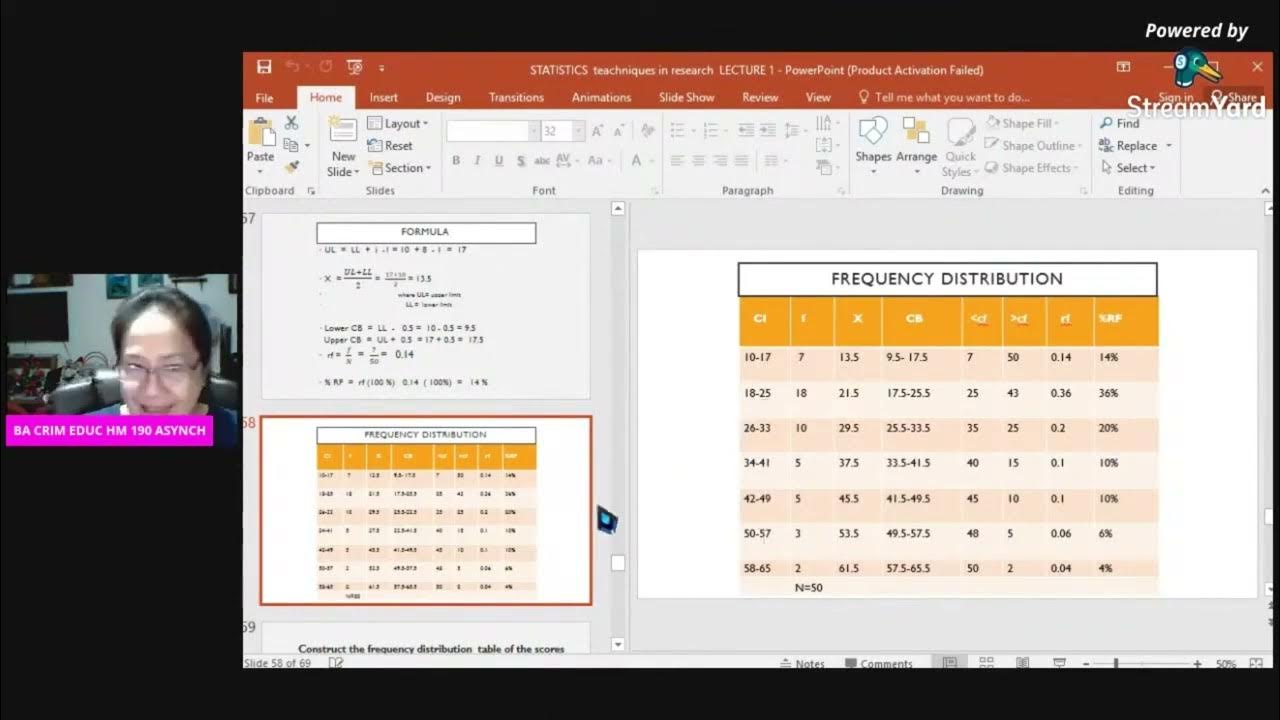Menentukan Nilai Modus Data Kelompok Matematika SMA
Summary
TLDRThis video tutorial focuses on explaining the statistical concept of 'mode' (moda) in a simple and engaging way. The presenter walks viewers through the process of identifying the mode in a dataset, including how to calculate it using a specific formula. Key steps include determining the class interval with the highest frequency, calculating necessary differences (D1 and D2), and applying the formula to find the mode. The tutorial emphasizes understanding the frequency distribution and offers helpful tips to work through the problem effectively. Viewers are encouraged to ask questions if needed.
Takeaways
- 😀 Modus refers to the mode in statistics, which is the value that appears most frequently in a data set.
- 😀 The symbol for mode is 'M', and it's used to represent the most frequently occurring value.
- 😀 A basic formula to calculate the mode involves determining the class with the highest frequency, and then applying specific equations to find the value.
- 😀 The class with the highest frequency is called the 'modus class,' and identifying it is key in finding the mode.
- 😀 To calculate the mode, you need to determine the 'lower boundary' (tepi bawah) and the 'upper boundary' (tepi atas) of the modus class.
- 😀 The formula for calculating the mode uses values like the lower boundary (TB), the class length (which is 5 in this case), and the differences in frequencies before and after the modus class.
- 😀 The mode calculation involves finding two values: D1 (the difference in frequency between the modus class and the previous class) and D2 (the difference between the modus class and the next class).
- 😀 The formula for calculating the mode is: TB + (class length * (D1 / (D1 + D2))).
- 😀 If the frequency before or after the modus class is zero, it doesn't affect the calculation of D1 and D2, making the process more straightforward.
- 😀 The mode formula and its calculations are simplified with basic arithmetic, but a calculator can be used if needed for precise results.
Q & A
What is the main topic discussed in this video?
-The main topic of the video is about statistics, specifically the concept of the mode (modus) and how to calculate it using class intervals.
What is the definition of the mode (modus) in statistics?
-The mode (modus) is the value or class interval that appears most frequently in a data set. It is the data point that occurs with the highest frequency.
How is the mode represented in the formula presented in the video?
-The mode is represented by the symbol 'M' in the formula, where M is calculated using the class boundaries, the frequencies of the class intervals, and the differences in frequencies.
What is the significance of finding the class mode in this calculation?
-The class mode is significant because it is the class interval with the highest frequency, which is used to calculate the mode for grouped data.
What is the formula used to calculate the mode in the video?
-The formula for calculating the mode is: Mode = Lower boundary of the modal class + [(D1 / (D1 + D2)) * Class width], where D1 and D2 are differences in frequencies of the modal class compared to the previous and next classes.
How do you determine the modal class?
-The modal class is determined by identifying the class interval with the highest frequency in the data set.
What does the 'D1' and 'D2' represent in the formula?
-In the formula, 'D1' represents the difference in frequency between the modal class and the class before it, while 'D2' represents the difference in frequency between the modal class and the class after it.
What is the process for calculating the mode in the given example?
-In the example, the modal class is identified based on the highest frequency, and then the mode is calculated by applying the formula with the correct class boundaries and frequency differences (D1 and D2). The result is 61.5.
What should you do if there are two classes with the same highest frequency?
-If two classes have the same highest frequency, there is no single clear modal class. In such cases, further analysis or adjustments may be required to handle the data appropriately.
What should you remember when applying the formula for calculating the mode?
-When applying the formula, you must correctly identify the modal class, use the correct class boundaries, and accurately calculate D1 and D2. It's important to remember that the mode formula involves the differences in frequency before and after the modal class.
Outlines

Этот раздел доступен только подписчикам платных тарифов. Пожалуйста, перейдите на платный тариф для доступа.
Перейти на платный тарифMindmap

Этот раздел доступен только подписчикам платных тарифов. Пожалуйста, перейдите на платный тариф для доступа.
Перейти на платный тарифKeywords

Этот раздел доступен только подписчикам платных тарифов. Пожалуйста, перейдите на платный тариф для доступа.
Перейти на платный тарифHighlights

Этот раздел доступен только подписчикам платных тарифов. Пожалуйста, перейдите на платный тариф для доступа.
Перейти на платный тарифTranscripts

Этот раздел доступен только подписчикам платных тарифов. Пожалуйста, перейдите на платный тариф для доступа.
Перейти на платный тарифПосмотреть больше похожих видео

1. WHAT IS STATISTICAL MODELLING

Tutorial 4- Measure Of Central Tendency- Mean, Median And Mode In Hindi

STATISTIKA || Mean, median dan Modus data tunggal || Data ganjil dan data genap

BA CRIM EDUC HM 190 VIDEO 1 2024

CARA MENENTUKAN MEAN MEDIAN MODUS DATA TUNGGAL||STATISTIKA

MÉDIA, MODA e MEDIANA | RÁPIDO E FÁCIL
5.0 / 5 (0 votes)
